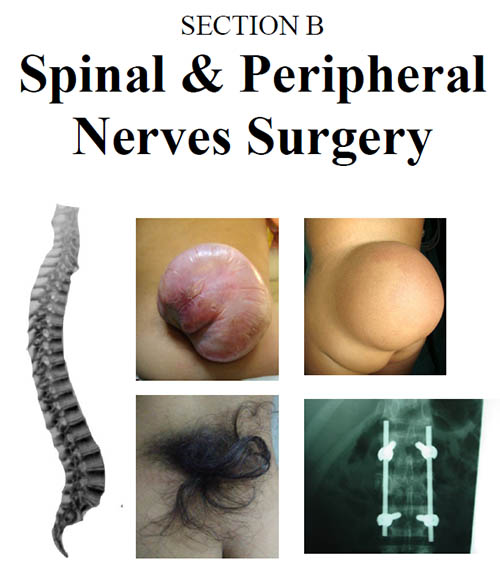Endoscopic Discectomy versus Microscopic Discectomy
DOI:
https://doi.org/10.36552/pjns.v25i1.532Keywords:
Endoscopic Discectomy, Lumbar Disc Prolapse, Backache, Oswestry Disability Index, Visual Analog ScoreAbstract
Objective: A randomized control trial was conducted to compare the outcome of an endoscopic discectomy with microdiscectomy in lumbar spine disc disease.
Material and Methods: A randomized control trial was conducted at the Department of Neurosurgery, Punjab Institute of Neurosciences (PINS), Lahore. We included 80 patients of ages between 13 – 65 years, with low backache with radiation towards legs and prolapsed intervertebral disc at L5 – S1 and L4 – L5 levels on MRI were included in the study. Endoscopic/microscopic discectomy was done in a randomized manner under general anesthesia in a prone position with fluoro guidance. Postoperatively, all patients stayed in the recovery room for two hours for monitoring and then shifted to the ward. All patients followed-up-to one year clinically with the help of the Oswestry disability index (ODI).
Results: There were 37 female and 43 male patients in the ages between 13 – 65 years. The mean age of patients was 53.5 years. The 53 patients were having prolapsed disc at L5 S1 levels and 27 patients with disc prolapse at L4 – 5 levels. A good improvement was observed in visual analog scores after surgery in both endoscopic and microscopic discectomy groups. But endoscopic discectomy group required a lesser hospital stay, early mobilization, and lesser postoperative analgesia requirements than the microscopic group.
Conclusion: Endoscopic/microdiscectomy both are equally effective and safer techniques. They both can relief. However, the endoscopic discectomy was found better in terms of early mobilization and lesser postoperative pain.
References
2. Boonstra AM, Preuper HRS, Reneman MF, Posthumus JB, Stewart RE. Reliability and validity of the visual analogue scale for disability in patients with chronic musculoskeletal pain. Int J Rehabil Res. 2008; 31: 165–169.
3. Ma D, Liang Y, Wang D, Liu Z, Zhang W, Ma T,
et al. Trend of the incidence of lumbar disc herniation: decreasing with aging in the elderly. Clin Interv Aging, 2013; 8: 1047–1050.
4. Mixter WJ, Barr JS. Rupture of intervertebral disc with involvement of spinal canal. New Eng. J Med. 1934; 211: 210-14.
5. Ward SR, Kim CW, Eng CM et al. Architectural analysis and intraoperative measurements demonstrate the unique design of the multifidus muscle for lumbar spine stability. J Bone Jt Surg Am. 2009; 91 (1): 176–185.
6. Kambin P. Arthroscopic Microdiscectomy Minimal Intervention. In: Kambin P (Ed). Spinal Surgery. Text Urban and Schwarzenberg Baltimore, MD, 1991: pp. 67–100.
7. Gautschi OP, Cadosch D, Hildebrandt G.Acute low back pain—assessment and management. Praxis. 2008; 97 (2): 58–68.
8. Wenger M, Mariani L, Kalbarczyk A, Gröger U. Long-term outcome of 104 patients after lumbar sequestrectomy according to Williams. Neurosurgery, 2001; 49 (2): 329–335.
9. J. N. A. Gibson, J. G. Cowie, and M. Iprenburg. Transforaminal endoscopic spinal surgery: the future ‘gold standard’ for discectomy?—a review. The Surgeon, 2012; 10 (5): 290–296.
10. Ruetten S, Komp M, Merk H, Godolias G, Recurrent lumbar disc herniation after conventional discectomy: a prospective, randomized study comparing full-endoscopic interlaminar and transforaminal versus microsurgical revision. Journal of Spinal Disorders & Techniques, 2009; 22
(2): 122–129.
11. Lewandrowski K-U. Incidence, management, and cost of complications after transforaminal endoscopic decompression surgery for lumbar foraminal and lateral recess stenosis: a value proposition for outpatient ambulatory surgery. Int J Spine Surg. 2019; 13 (1): 53–67.
12. Ruetten S, Komp M, Merk H, Godolias G. Full-endoscopic interlaminar and transforaminal lumbar discectomy versus conventional microsurgical technique: a prospective, randomized, controlled study. Spine (Phila Pa 1976), 2008; 33 (9): 931–939.
13. Yeung A, Gore S. Endoscopic foraminal decompression for failed back surgery syndrome under local anesthesia. Int J Spine Surg. 2014; 8: 22.
14. Ross JS, Robertson JT, Frederickson RCA, et al. Association between peridural scar and recurrent radicular pain after lumbar discectomy: magnetic resonance evaluation. Neurosurgery, 1996; 38 (4): 855–861.
15. Teli M, Lovi A, Brayda-Bruno M, Zagra A, Corriero A, Giudici F, et al. Higher risk of dural tears and recurrent herniation with lumbar micro-endoscopic discectomy. Eur Spine J. 2010; 19: 443–50.
16. Zhou Y, Wang M, Wang J, Chu TW, Zhang ZF, Li CQ. Clinical experience and results of lumbar microendoscopic discectomy: A study with a five-year follow-up. Orthop Surg. 2009; 1: 171–5.
17. Xu H, Liu X, Liu G, Zhao J, Fu Q, Xu B. Learning curve of full-endoscopic technique through interlaminar approach for L5/ S1 disk herniations. Cell Biochem Biophys. 2014; 70: 1069–74.
18. Hsu HT, Chang SJ, Yang SS, Chai CL. Learning curve of full-endoscopic lumbar discectomy. Eur Spine J. 2013; 22: 727–33.
19. Fei Q, Li J, Lin J, et al. Risk factors for surgical site infection after spinal surgery: a meta-analysis. World Neurosurg. 2016; 95: 507–515.

Downloads
Published
Issue
Section
License
The work published by PJNS is licensed under a Creative Commons Attribution-NonCommercial 4.0 International (CC BY-NC 4.0). Copyrights on any open access article published by Pakistan Journal of Neurological Surgery are retained by the author(s).












